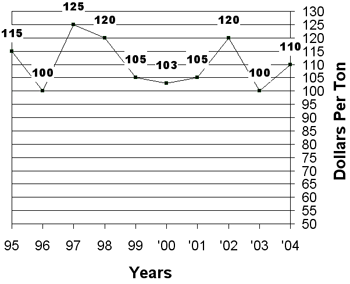Production Update:
Rain damaged Hay: Alfalfa must be dried or cured for safe storage as hay. Field and harvesting losses of hay are normally as high as 20 to 30%. Rain can increase these yield losses and reduce quality. Rain extends curing time and yield and quality are decreased due to loss of leaves, plant respiration, and leaching of nutrients. In a Utah study, artificial rain of 0.8 inches resulted in losses of yield (10%), available carbohydrate (19%), crude protein (10%), soluble minerals (14%), and total lipids (20%). Carotene, the precursor for Vitamin A, is sensitive to prolonged field exposure. Vitamin A is the most common vitamin deficiency in beef cows and horses.
Insect Management: Spider mites in alfalfa may be associated
with water stress and infestations may clear up a few days after an irrigation.
Infestations start in the lower plant canopy moving upward and leaves
are covered with webbing. Spider mites insert needle-like mouth parts
into leaves removing plant sap, causing a yellow stippling on leaves (picture).
With severe feeding leaves turn brown, become dry, and drop from the plant.
Feeding damage reduces yield, quality and retards regrowth. Spider Mite
Species in Western Arizona and Southern California include: carmine spider
mite (T. cinnabarinus Boisdival) (
picture);
desert spider mite (T. desortorum Banks); strawberry mite (T.
turkestani Ugarov & Nikolski) (
picture),
and twospotted spider mite (Tetranychusurticae Koch) (
picture).
Pyrethroid insecticides can flare spider mite infestations. Sulfur may
be used to suppress the populations.
Weed Control: Field and southern sandbur (picture)
are controlled by preemergent applications of Triflurilan and Eptam unless
it has survived the winter. Very early (1-2 leaf) postemergence application
of Poast and Select/Prism will control seedling sandbur. This weed cannot
be controlled selectively in alfalfa if it has overwintered or become
well established.
| Market Summary |
High
|
Low
|
Average
|
Off grade
|
| Past 2 Weeks |
125
|
100
|
110
|
85-95
|
| Last Year |
102
|
95
|
100
|
85-95
|
10 Year Summary (March 23, to April 5, 1995-2004):

Issued in furtherance of Cooperative Extension work, acts of May 8 and June 30, 1914, in cooperation with the U.S. Department of Agriculture, James A. Christenson, Director Cooperative Extension, College of Agriculture and Life Sciences, The University of Arizona.
The University of Arizona is an equal opportunity, affirmative action institution. The University does not discriminate on the basis of race, color, religion, sex, national origin, age, disability, veteran status, or sexual orientation in its programs and activities.
Any products, services, or organizations that are
mentioned, shown, or indirectly implied in this web document do not imply
endorsement by The University of Arizona.
Information provided by:
Barry Tickes, btickes@ag.arizona.edu Extension Agent, Yuma County
Michael Ottman, mottman@ag.arizona.edu Agronomy Specialist
College of Agriculture, The University of Arizona.
Eric Natwick, etnatwick@ucdavis.edu UCCE Imperial County - Farm Advisor
University of California, Davis, CA.
Forages: Crop Mgmt | Soil Mgmt | Irrigation | Alfalfa Reports | Insects | Diseases | Weeds | Pesticides
Home | Other Crops | Forages
For more Arizona Production Ag Information:
Home | Cotton | Veggies| Forages | Grains | Citrus | Crop x Crop | Insects | Diseases| Weeds | Pesticides | News | Weather | Research | Photos | Contacts | General Info. | Site Map
Copyright © 2001 University of Arizona,
College of Agriculture and Life Sciences
Webmaster: Al Fournier (fournier@ag.arizona.edu)